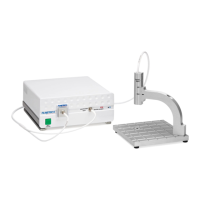Use Manually Set Parameters
Users can set the integration time per acquisition cycle and set a number of integration cycles over
which to average. When using this option, the total sampling time is equal to the integration time
multiplied by the number of integration cycles.
To set the integration time manually, set the sample on the stage and select Setup>Raw Signal…
If the proper integration time is unknown, an initial value of 40ms is a good starting guess. The ver-
tical scale of the spectrum extends from zero to 4095. Thus, a good working level is when the peak
height of the sample being measured, or the reference sample, whichever is greater, is 3000-3500
counts. (Note: if the reference measurement saturates – Detector Saturation error – then spurious
final measurements will result.) If the maximum signal is too low, increase the integration time.
Too large an integration time will result in excessive dark current, so it is sometimes necessary to
accept a smaller signal level to limit the dark current.
* * Note * * If the integration time is changed, it will be necessary to perform the baseline pro-
cedure, or re-acquire the background and reference scans.
Spectrometer Type
EXR and UVX systems have two spectrometers (VIS/UV and NIR). Here the user can choose to
use only one or both spectrometers.

